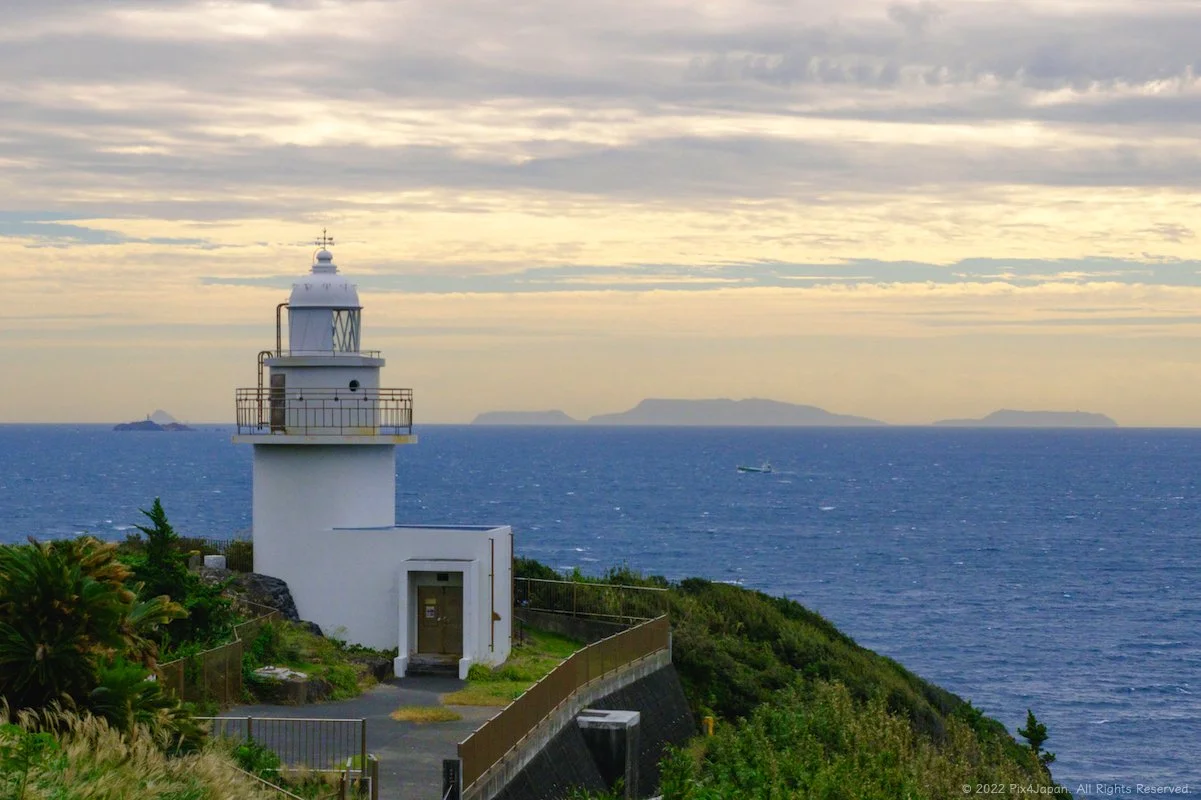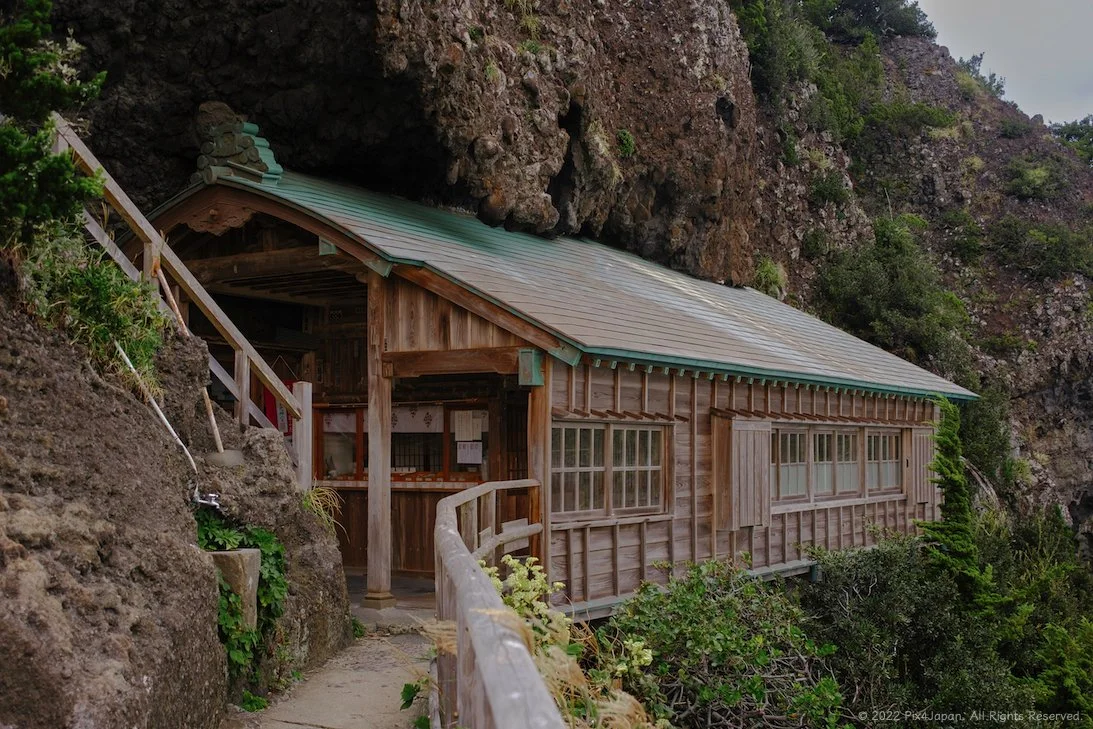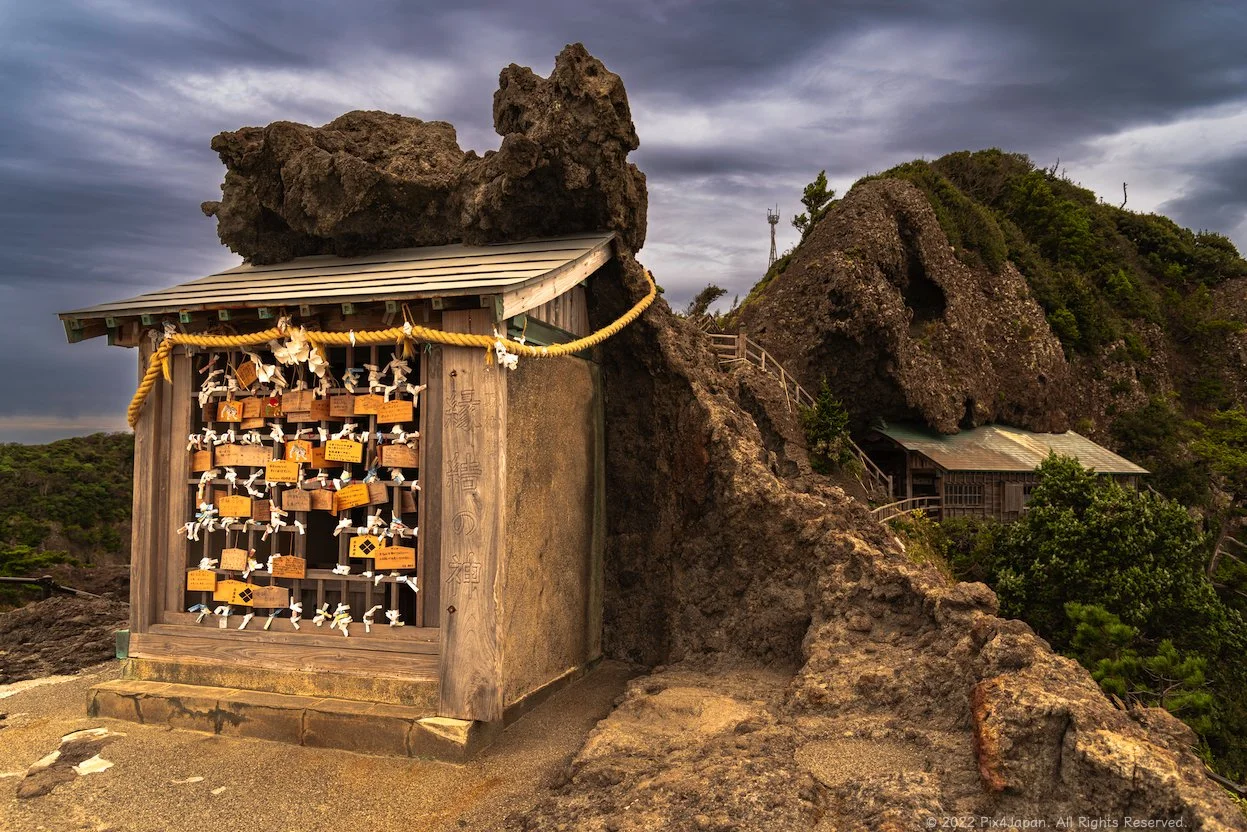Cape Irozaki, Japan
Pentax K-1 II + DFA 28-105mm F3.5-5.6
95 mm ISO 100 for 480 sec. at ƒ/6.3
Cape Irozaki Lighthouse
An 8-minute exposure of the Irozaki Lighthouse, which is located atop cliffs on the southernmost extremity of the Izu Peninsula.
Located about 192 km (121 mi) southwest of Tokyo, it took me about 3 hours to drive there via several expressways and by-pass highways.
The original lighthouse was built in 1871 by British engineer Richard Henry Brunton. The original wooden structure was destroyed in a severe windstorm in 1932. The current concrete structure was completed a year later in 1933.
Fujifilm X100V (23 mm) with 5% diffusion filter
ISO 160 for 1/1400 sec. at ƒ/6.4
Velvia/Vivid film simulation
Irozaki Lighthouse after Sunrise
Located atop cliffs on the southernmost extremity of the Izu Peninsula, the lighthouse is a short walk from Irozaki Ocean Park.
Although I drove to this site, you can access the cape via public transportation. From Izukyu-Shimoda Station on the Izu-Kyuko Line, take a 40-minute Tokai bus ride from the station to Irozakiko Bus Stop, which is located right in front of the Irozaki Ocean Park visitor center.
Even on an overcast morning, the cape offers grand views of the beautifully sculptured Izu coastline and views of several islands that are only a few kilometers off the coast.
Pentax K-1 II + DFA 28-105mm F3.5-5.6
31 mm ISO 100 for 1/80 sec. at ƒ/11
Shrine on Cliffs of Cape Irozaki (Izu, Japan)
The origins of Ishimuro Shrine are shrouded in mystery and various fantastic legends that include the mention of dragons. However, the original structure was most likely built in the year 701 according to inscriptions on a munafuda (small wooden planks/boards that are stored with temples and shrines upon completion of construction).
The shrine was built into a crevice/cave on the cliffs right above crashing waves below. This rock, like much of Izu’s beautiful and geologically unique coastline, was formed by lava flows that erupted from a submarine volcano. The amount of work and danger involved in building a shrine in this particular location without the convenience of modern machinery or technology is a feat in and of itself.
Locals from the numerous fishing villages nearby worship the shrine’s guardian deity of the sea and pray for maritime safety and business prosperity. Tourists can also visit the shrine and pray for academic success and even traffic safety. The shrine is actually manned by a priest selling the omamori (Japanese amulets). The priest was kind enough to watch and play with my dog while I entered the shrine to make an offering and prayer.
Fujifilm X100V (23 mm) with 5% diffusion filter
ISO 160 for 1/280 sec. at ƒ/2.5
Velvia/Vivid film simulation
Legend of Ishimuro Shrine (Izu, Japan)
According to one of a few ancient legends, a Japanese ascetic and mystic named En-no-Ozunu visited the Izu Peninsula in the year 700 with a statue of the Eleven-Headed Kannon (bodhisattva of mercy who protects people from illness and helps them secure food and wealth).
During his visit, there was a huge earthquake at which time a dragon and a swan appeared at the tip of Cape Irozaki. The dragon guarded the huge rock at the top of the cliffs, and the swan guarded the shoreline below the cliffs. The night before the earthquake, one villager had a dream where he saw the shrine emerge from the sea and settle in the cave halfway up the cliffs.
Upon hearing these stories from the astonished villagers, En-no-Ozunu set out to find this mysterious shrine with the Kannon statue in hand.
En-no-Ozunu reached the cape and found the shrine tucked into the side of the cliffs where he then placed the Kannon statue in the shrine where it became enshrined and worshiped by the local villagers and fishermen.
Pentax K-1 II + DFA 28-105mm F3.5-5.6
37 mm ISO 100 for 1/80 sec. at ƒ/11
Pentax K-1 II + DFA 28-105mm F3.5-5.6
73 mm ISO 100 for 1/200 sec. at ƒ/5.6
Pentax K-1 II + DFA 28-105mm F3.5-5.6
28 mm ISO 100 for 1/250 sec. at ƒ/5.6
Two Shrines on Cliffs of Cape Irozaki (Izu, Japan)
On the right is Iro Shrine–a larger and older structure that is built into the side of cliffs right above crashing waves below. A deity of maritime safety, prosperous business, and academic success is enshrined at this shrine. The origins of this shrine date back to over 1,300 years.
On the left is Kumano Shrine–a very small structure at the furthermost end of the cape where a deity of marriage is enshrined. Origins of this shrine are unclear, but is associated with a legend of a young couple who overcame challenges and lived happily ever after.
Kumano Shrine is a more popular destination for couples visiting Irozaki Cape. Not only are the views of the lighthouse and beautiful coastline ideal for a romantic date, Kumano Shrine is where couples in a serious relationship might want to visit. Couples can write their wish or prayer on an ema (wooden plaque) and attach it to the shrine in the hope of a happy and successful marriage.
Pentax K-1 II + DFA 28-105mm F3.5-5.6
28 mm ISO 400 for 1/160 sec. at ƒ/11
Shrine for Lovers
Kumano Shrine located at the furthermost end of Cape Irozaki on the Izu Peninsula in Shizuoka Prefecture (Japan) is where a deity of marriage is enshrined.
Origins of this shrine are unclear, but is associated with a legend of a young couple who overcame challenges and lived happily ever after.
In this shot, you can see omikuji (random fortunes printed on strips of paper) and wooden ema boards, which are used to inscribe your wishes or prayers to the deity of the shrine.
The omikuji were originally used to divine the gods’ opinion on important matters, such as choosing successors, determining battle strategy, etc., and was an extremely sacred occasion. In modern days, anyone can freely purchase an omikuji in hopes of getting a good fortune.
Due to the association with a deity of marriage, ema boards/plaques are attached to Kumano Shrine are often inscribed with wishes or prayers for good matchmaking.
Pentax K-1 II + DFA 28-105mm F3.5-5.6
63 mm ISO 400 for 1/160 sec. at ƒ/11
Legend of Kumano Shrine
A long long time ago, Oshizu, the daughter of a village chief, and Kokichi, a fisherman from a nearby village, fell in love with each other without the permission of Oshizu’s parents.
The couple were forced to split up by Oshizu’s parents due to the difference in their social class, and Kokichi was exiled to the distant island of Mikomoto off the shores of Cape Irozaki.
Oshizu and Kokichi were inseparable and could never forget their love for each other. So, Oshizu and Kokichi lit fires every night from atop the cliffs above the sea to signal to each other that they were safe, and to symbolize their unfettering love for each other.
One night, Oshizu’s heart sunk after not seeing the Kokichi’s fire on Mikomoto Island. With worry and panic setting in, Oshizu secretly set out on a small boat for Mikomoto Island and prayed to the gods with all her heart that she would be guided to Kokichi on the Island. After drifting all night under a full moon, Kokichi found her on the shores of Mikomoto Island.
Upon hearing this story, Oshizu’s parents forgave her and Kokichi, and allowed the couple to marry wherein they lived happily ever after.
Kumano Shrine in the photo was built on the site of Oshizu’s nightly fires. Since then, the enshrined deity became known as the god of marriage among the villagers and following generations.
Below is a list of the equipment I took with me on this photo shoot.
Camera Gear:
Pentax K-1 Mark II (K1-II)
Standard zoom lens: Pentax D FA 28-105mm f3.5-5.6ed DC WR HD Lens
Tripod: Manfrotto MT190CXPRO4 (carbon fiber legs with quick locking clamps)
Ball head: Manfrotto Cloud XPRO Series Ballhead BHQ2 with 200PL locking plate
Fujifilm X100V
Moment Camera Filter 5% CineBloom Diffusion Filter
Haoge LH-ES3 Square Metal Lens Hood with Hollow Out Design 49mm Adapter Ring with Cap
Fujifilm PRF-49S
Video Gear:
Canon EOS Kiss M/M50 Double Zoom Kit
SIGMA 16mm F1.4 DC DN | Contemporary C017 (Canon EF-M Mount, APS-C Size, Mirrorless Only)
PolarPro 67mm QuartzLine Circular Polarizer Filter
Zhiyun Weebill-S Gimbal
RODE Road Wireless GO Wireless Microphone System WIGO
Filters & Filter Systems:
PolarPro QuartzLine ND 64 Filter - 67mm (ND64 6-stop reduction in light)
PolarPro QuartzLine ND1000 Filter - 67mm (ND1000 10-stop reduction in light)
PolarPro QuartzLine ND100k Filter - 67mm (ND100K 15-stop reduction in light)
PolarPro QuartzLine Circular Polarizer - 67mm
PolarPro Summit | Landscape Filter System Custom Kit (Core, Thread Plate, ND4-GR filter, ND8-GR filter, Circular Polarizer)
Pack:
F-stop Tilopa 50L Adventure and Travel Camera Backpack (Essentials Bundle: backpack, rain cover, internal camera unit)
F-stop Tripod Bag (large)
*Links to Amazon are affiliated links, which means that if you choose to purchase an item that I may get a small commission, which has no effect on your purchase price whatsoever.
© 2022 Pix4Japan. All rights reserved.








